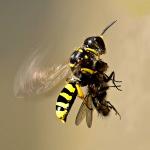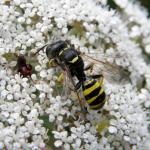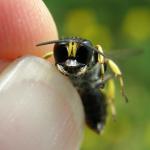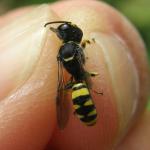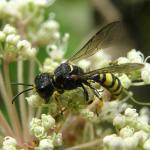Crabro aciculatus (PROVANCHER,1882); Crabro cephalotes (PANZER,1799); Crabro cephalotes (PANZER,1799); Crabro fargeii (SMITH,1856); Crabro floralis (OLIVIER,1792); Crabro geniculatus (OLIVIER,1792); Crabro interruptus (DAHLBOM,1845); Crabro lindenius (SHUCKARD,1837); Crabro ornatus (LEPELETIER & BRULLÉ,1835); Ectemnius quadricinctus misident.; Crabro ruthenicus (MORAWITZ,1892); Crabro shuckardi (DAHLBOM,1845); Blepharipus striatulus (LEPELETIER & BRULLÉ,1835); Crabro striatus (LEPELETIER & BRULLÉ,1835); Crabro tibialis (OLIVIER,1792)
One of the more common large Ectemnius species easily identified in both sexes by the densely striate mesoscutum with transverse striae on the front half.
Widely distributed in England and Wales, and frequent in many areas. Rare in Scotland, with the most northerly record to date from a site in the Dundee area. Recorded in Ireland for the first time in 1996 in County Dublin (C Ronayne, pers. comm.). Well established in the Channel Islands. Nomenclatural confusion within the genus up to the beginning of the century renders many old literature records unreliable. A Holarctic species occurring throughout much of Europe from England to the Urals and Caucasus; also in south-east Canada and north-east USA, where it may have been introduced (Lomholdt, 1975-76).
This species is not regarded as being scarce or threatened.
Can be encountered in a wide variety of situations including rides and clearings in woodland, open countryside of many sorts, coastal habitats and urban locations. Usually most apparent around large pieces of dead wood or on umbellifer flowers nearby.
Univoltine; early June to late September, with a peak from late June to late August.
Medium-sized flies, such as syrphids, tabanids and various calypterate and acalypterate groups (Hamm & Richards, 1926; Spooner, 1934).
Nest tunnels are excavated in fairly large pieces of dead wood such as stumps, fallen tree trunks, rotting logs and occasionally building timbers. Nesting aggregations can be large and dense, and this is one of several wood-nesting sphecids where more than one female has been recorded using a common nest entrance.
Umbellifers such as angelica, hogweed, and wild parsnip.
The anthomyiid fly Eustalomyla festiva is often found close to nesting aggregations of this wasp, and it is possible that sarcophagid flies of the genera Amobia and Macronychia also exploit E. cephalotes.
1998


